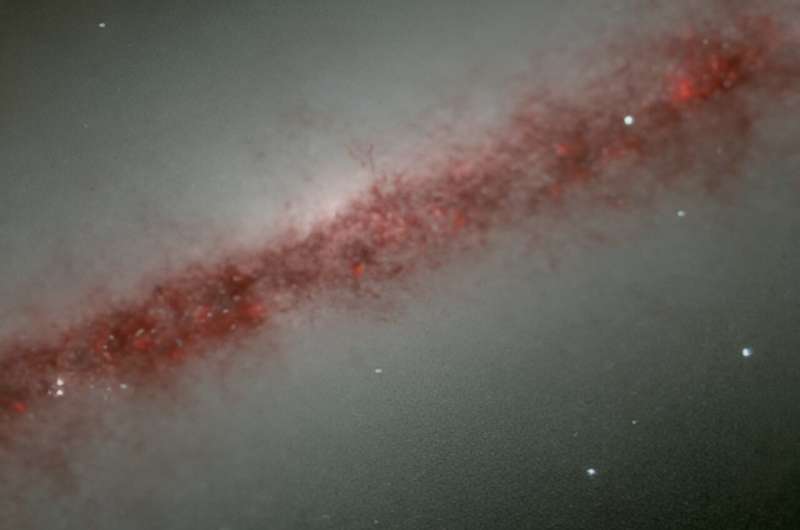August 22, 2024 report
This article has been reviewed according to Science X's editorial process and policies. Editors have highlighted the following attributes while ensuring the content's credibility:
fact-checked
preprint
trusted source
proofread
Astronomers explore the nature of galaxy NGC 891 with JWST

Using the James Webb Space Telescope (JWST), an international team of astronomers has observed a nearby spiral galaxy known as NGC 891. Results of the observational campaign, published August 15 on the preprint server arXiv, provide more insights into the nature of this galaxy and its circumgalactic medium.
Discovered in 1784, NGC 891 (also known as Caldwell 23 or the Silver Sliver Galaxy) is an edge-on, unbarred spiral galaxy located some 30 million light years away. It has a size of about 100,000 light years and is classified as a normal star-forming spiral galaxy with similarities to the Milky Way but with a slightly higher global star-formation rate (SFR).
Aiming to shed more light on the properties of NGC 891, a group of astronomers led by Jérémy Chastenet of the Ghent University in Belgium, decided to investigate this galaxy's circumgalactic medium (CGM) using JWST's Mid-Infrared Instrument (MIRI) and the Near-Infrared Camera (NIRCam).
"In this paper, we focus on the distribution of dust and stars in the disk-halo interface of the prototypical edge-on galaxy NGC 891 probed by the MIRI and NIRCam instruments on-board JWST. The unprecedented resolution and sensitivity of JWST let us resolve and study substructures in the CGM, which was never possible at these wavelengths," the researchers wrote in the study.
JWST allowed Chastenet's team to detect dust emission out to about 13,000 light years from the disk of NGC 891. This emission was identified in the form of filaments, arcs and super-bubbles.
It turned out that some of these filaments connect back to the mid-plane, to regions of high star formation rate in NGC 891. This finding suggests that feedback-driven galactic winds play an important role in regulating baryonic cycling.
Furthermore, the observations detected in NGC 891 the presence of dust in the form of small grains, and also likely polycyclic aromatic hydrocarbons (PAHs). Trying to explain the survival of dusty material for several tens of million years after having been ejected by galactic winds in the disk-halo interface, the astronomers offer the two most plausible scenarios.
"These small grains could be present in pockets of dense material and protected from ionizing radiation; this scenario agrees with simulations and a good match between emission and extinction in the literature," the researchers explained.
They added that the emission can also come from the surface layers of clouds, where the differential wind speed between hot and warm gas is enough to create a mixing layer, replenished by cooling material from the hot gas phase.
Further spectroscopic observations of the CGM in NGC 891 should be conducted in order to confirm which of the hypotheses is true.
More information: Jérémy Chastenet et al, JWST MIRI and NIRCam observations of NGC 891 and its circumgalactic medium, arXiv (2024). DOI: 10.48550/arxiv.2408.08026
Journal information: arXiv
© 2024 Science X Network





















